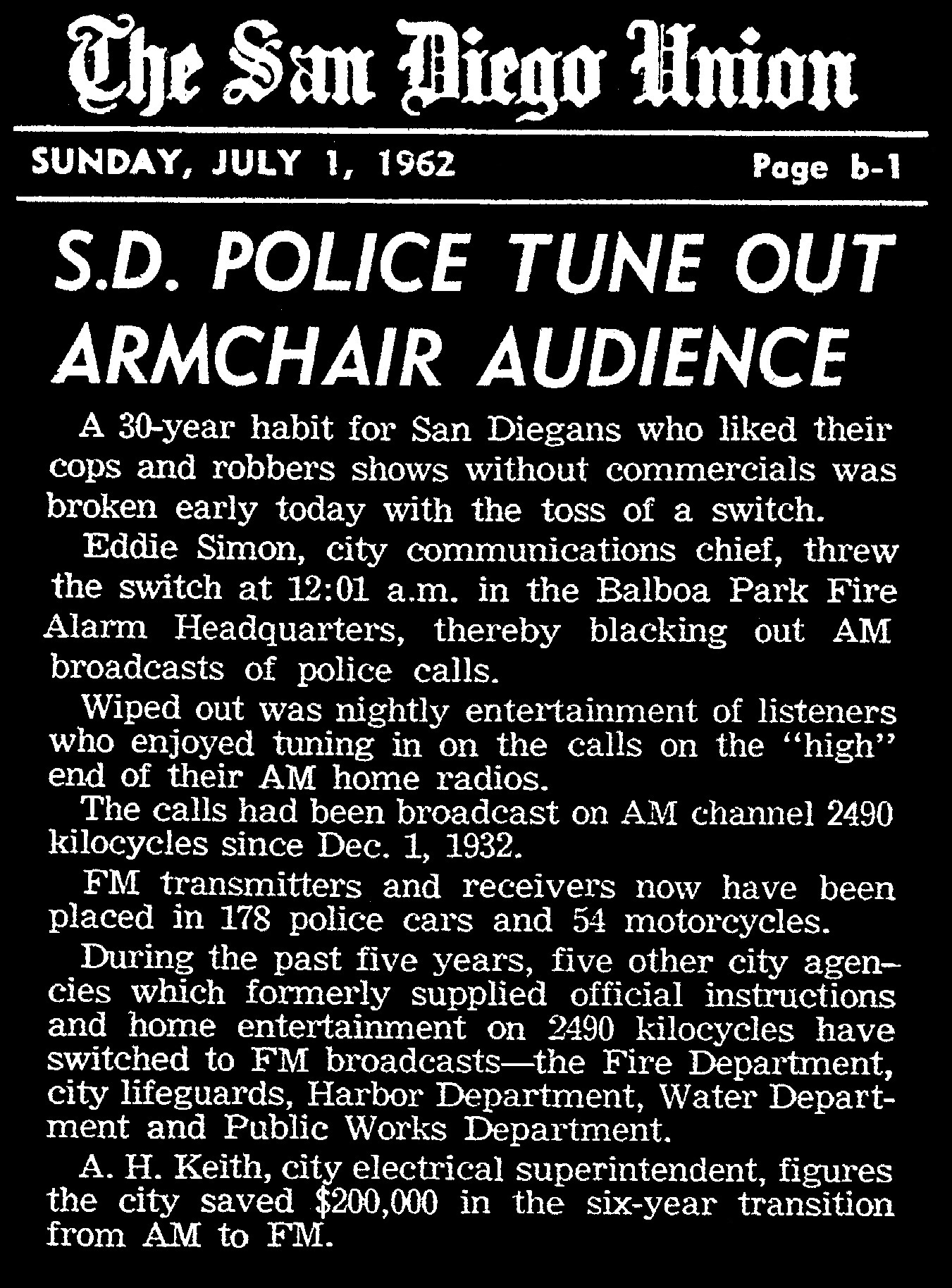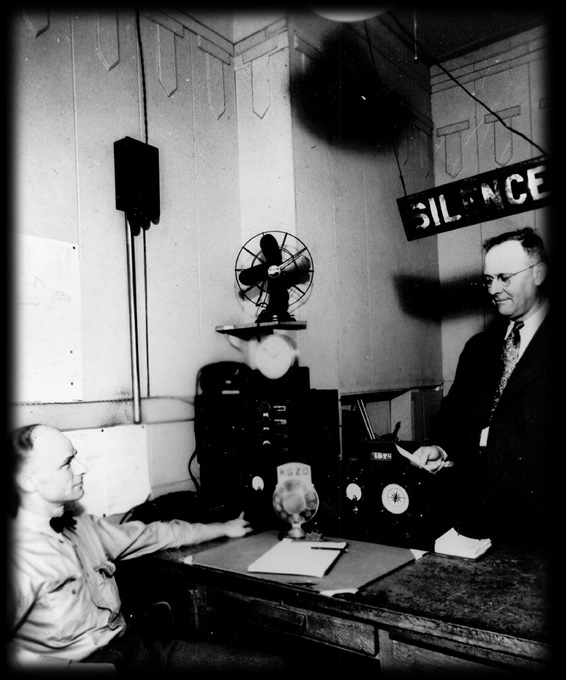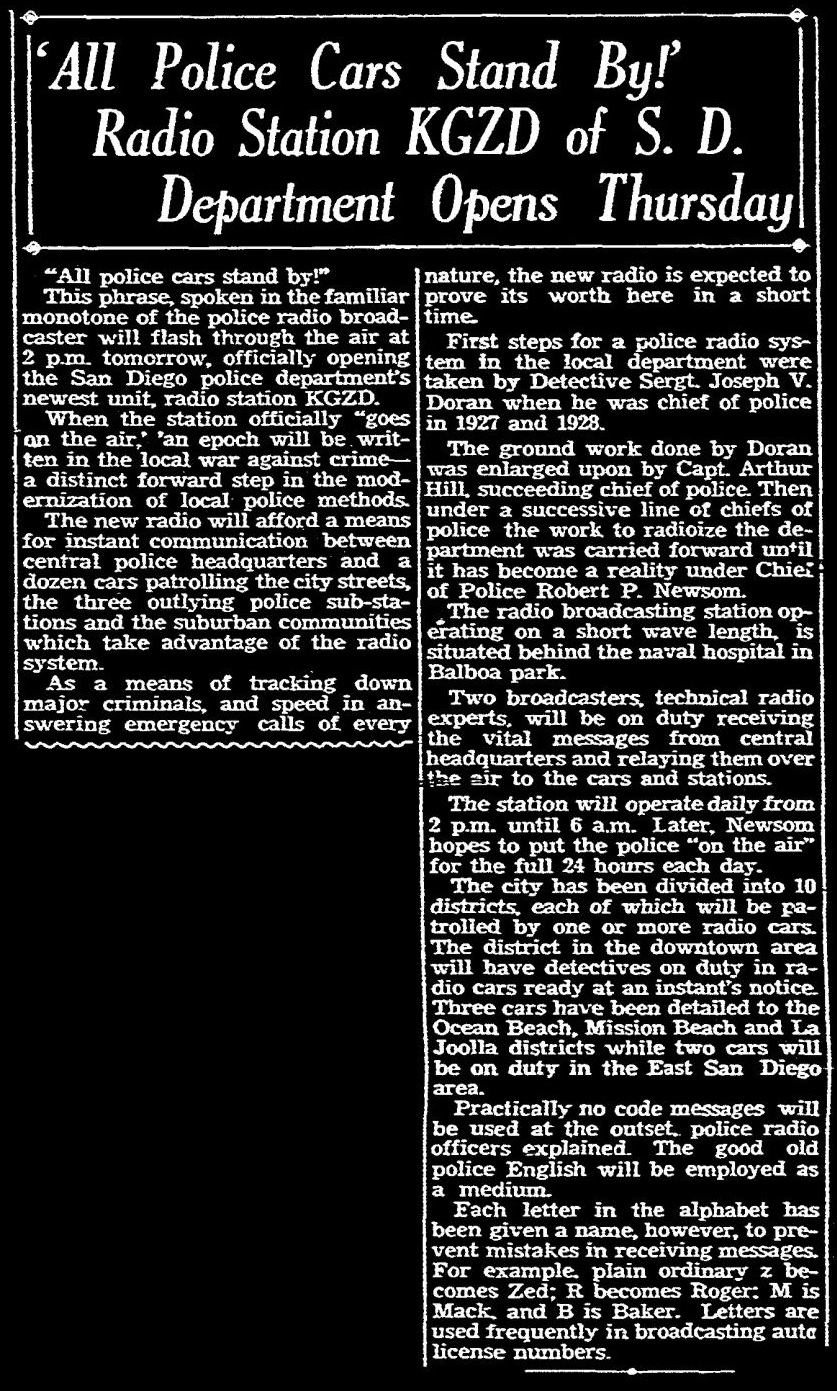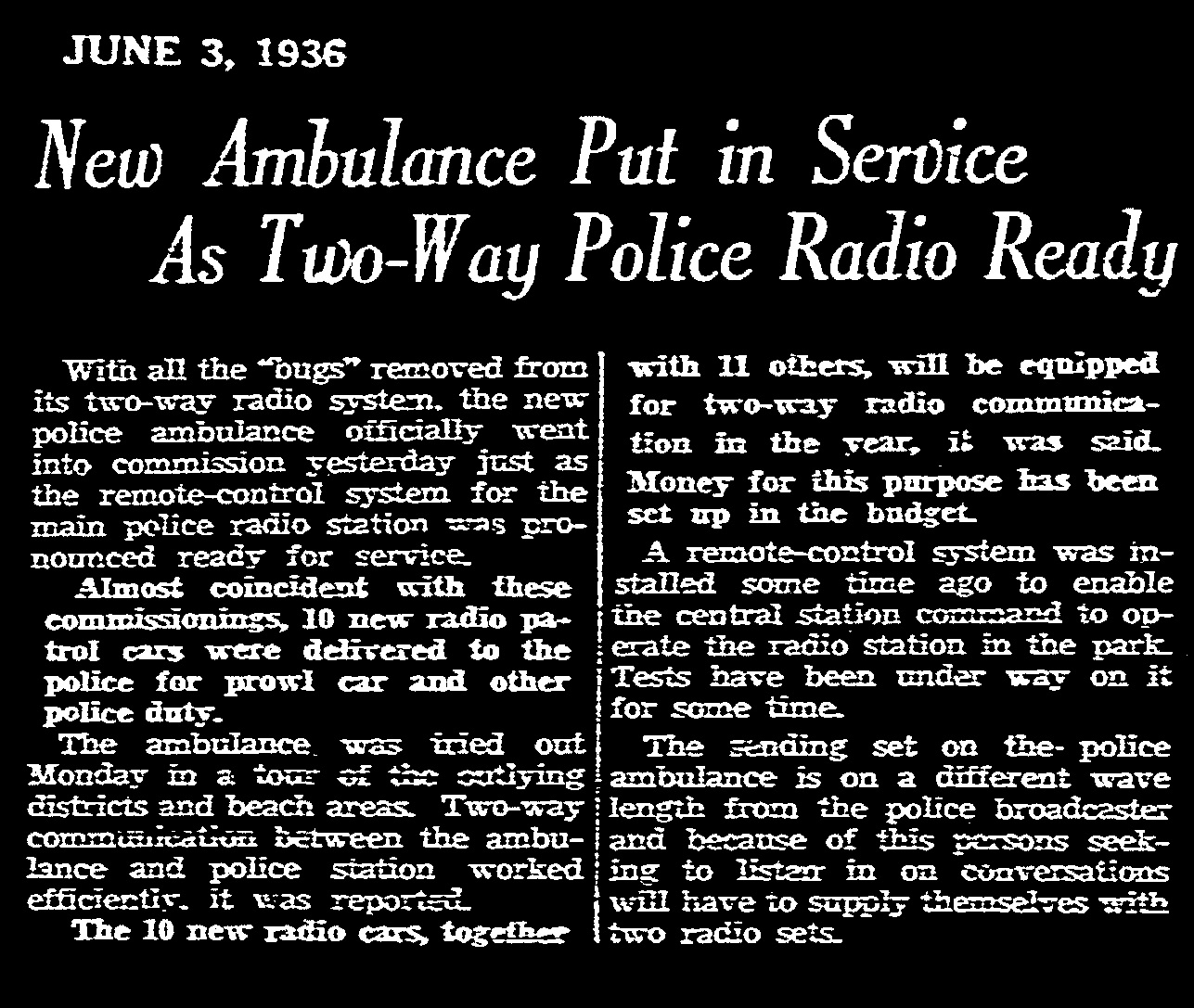
The start of the police radio in San Diego was fairly simple but long overdue.
SDPD had actually begun to move towards remote communications almost 20 years before when it established a system of flashing signal lights called the “Gamewell.”
With red lanterns hanging placed at strategic locations around the city, the Gamewell allowed an officer back at the station to throw a switch, illuminating the light. When a patrolman on the beat saw the light, he would contact the station.
Despite the advances, a radio system was needed for more efficient police patrol. Without a radio in the patrol cars, officers were forced to check in every 30 minutes at the police station or via callbox. For emergencies, motorcycle officers were assigned to the station waiting for calls to come in. These emergency riders knew,
more than anyone, something else was needed.
So it was a huge step forward when, in 1932, Chief Harry Scott announced the SDPD would be a one of the first agencies to use police
car radios.
The initial plan was for twenty police vehicles to be equipped for coverage around the clock. Scotts plan called for two police cars and an ambulance for East San Diego, five units for the beaches and northern areas of the city including downtown, and others for additional areas though out the city. Budgets being what they were however, only five cars city wide wound up being initially equipped. Those five cars officially became active on December 1, 1932, when Radio Operator Vernon “Tommy” Thompson, flipped a switch and uttered the words “KGZD is now on the air. Stand by for further broadcasts.”
Because the cars only had one way one-way radios Thompson had no way of knowing if the officers received the call until they telephoned him at the 30 minute check in time. 
Within a short period of time the radio system was in the news when an officer shot a
robber after the radio alerted him about the crime in progress however, there were issues along the way.
The dispatch center was located in a small cinder block shack on what is now the US Naval Hospital in Balboa Park. For protection, Thompson kept a shotgun by his side and locked the door. To assist Thompson, a second dispatcher, Herbert Holcomb, was hired.
Because of limited budgets, the initial set up of the radio system only allowed Thompson and Holcomb to work from 2 p.m. until 6 a.m. daily. Despite the primitive setup of the radio, it gave police something they had long been missing -a way to respond almost immediately to emergency calls for service.
At first,Thompson and Holcomb only
dispatched police calls. However, it wasn’t
long before other departments recognized
the value of the radio so the men soon found themselves busy handling fire department, sheriffs and highway patrol calls as well. It wouldn’t be until 1961 that all of the other agencies took to their own frequencies.
For the first few years there were no radio
codes used however officers were
instructed to use the phonetic system when spelling out license plates.
By 1936 the two-way transmitter began to
appear in San Diego police cars and by the
end of World War II all patrol cars were
equipped with a police radio. By mid year
It would be almost 40 more years before patrolmen assigned a walking beat would
have the luxury of having a portable radio
to carry on patrol. They were still relegated
to checking in through the call box every 30 minutes. Patrol officers in cars would
sometimes be dispatched to locate the
walking officer to notify him of a call. To
notify officers of an emergency call before the 30-minute check in, a flashing light was
installed on top of the callbox. If the light
was illuminated, a patrolman would go to
the box and call dispatch.
On April 30, 1940, dispatch was moved to
Street and Lt. Thad Seibert was placed in charge of the new Police Communications Division, then known as "The Business Office."
In October 1947, Chief Elmer Jansen announced he was relocating the Business Office within Police Headqarters to provided better public service. Lt. Frank Logan was placed in charge.
In light of the growing demand for the police radio, additional civilian dispatchers were hired to assist the several radio trained
police officers and Thompson. The new dispatchers were moved to a room below
the stations tower and the Business Office was formally established.
Under this system, a dispatcher answered
the telephone and evaluated the calls.
Once the caller information was taken, it
was written on a card and put into a
conveyer system to the radio room. Another
dispatcher would then alert the nearest
patrol unit. The new system marked the
first time the calls were actually received
by the dispatchers. Previously calls were received at the station and telephoned to
the shack to be dispatched because the
city hadn’t budgeted the money for a
system allowing the public to directly call Balboa Park.
In 1952 the police radio system was 20
years old. What started out as a simple system to communicate to five cars had evolved into a 24-hour system connecting more than 60 cars to the dispatch center. Thompson was still a dispatcher working
the day shift when the San Diego Union profiled the anniversary.
The dispatch system continued to grow adding both dispatchers and additional radio frequencies as needed. Using a mixture of police officers, cadets and civilian dispatchers, the department was forced
to be creative to meet the ever expanding needs of its communications system. By
the 1960’s the department found itself
using a system that was quickly becoming obsolete.
By the 1970's it was apparent an entirely
new dispatch system was needed. In addition, state law mandating a 9-1-1
system was pushing SDPD forward.
A task force was set up to research new
and innovative police emergency dispatch systems. As a result, in 1974 a new communications center was opened in
the basement of a city fire station
downtown. The system would serve until
the mid 1980's when once again a new system was needed.
This system was a leap into the 21st
century. The new plan called for police
cars to be equipped with not only a state
of the art 800-megahertz system, but also Mobile Data Terminals (MDT) allowing
officers to communicate through computer with the dispatch center. The computers
also allowed officers to research arrested individuals in the field. To pay for it, San Diego voters approved a 25 million dollar bond.
Today, the Communications Division is staffed by more than 100 dispatchers who work 24 hours a day 7 days a week.
Vernon "Tommy" Thompson (Left)
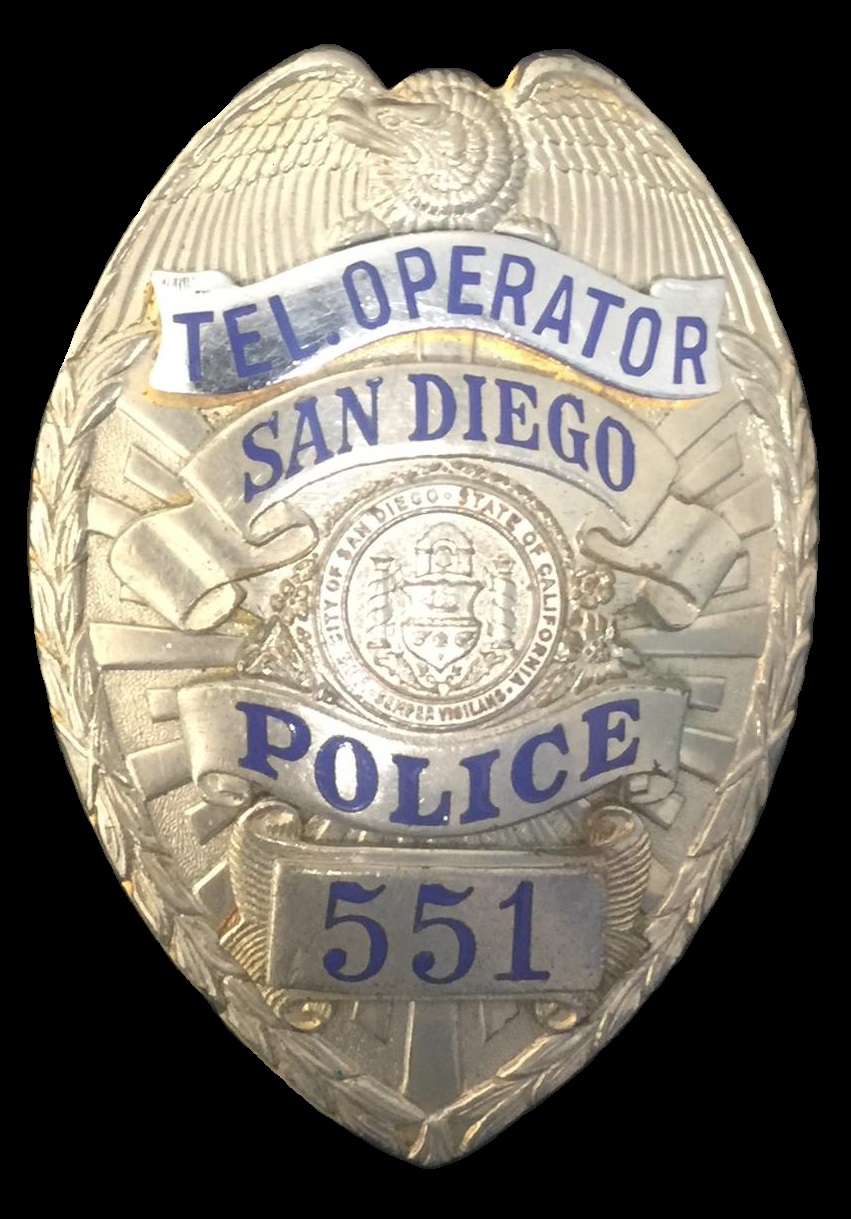


INTERESTED IN JOINING SDPD COMMUNICATIONS? CLICK THE BADGE
